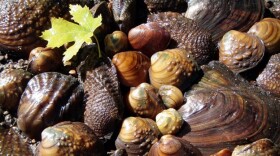Hi my name is Lonnie Parry, I am a Masters Student at the University of Wisconsin- Madison studying fisheries science. Today, I am going to guide us on an exploration of the fish of Vilas County, Wisconsin—an area blessed with an astounding 1,300 plus lakes. We will be talking about how the body shapes of some iconic native species tell us a lot about what they eat and where they live in our waters. From sleek predators to curious panfish, there’s a fascinating world just below the waves!
Let’s start with the muskellunge, Wisconsin’s famed “fish of 10,000 casts.” If you’ve ever seen one, you know they’re built for power and speed. Muskies have long, torpedo-shaped bodies and large, toothy mouths. These guys are serious top dog predators! Their sleek design allows them to ambush prey like perch, suckers, and smaller fish. When prey comes too close, their body shape allows them to explode with a burst of speed, striking with near exact precision. They often lurk in weed beds or along drop-offs, blending into the shadows, but these guys are not ones to stay hidden. You will often find these impressive predators right near the top or mid-level of the water column, where they can patrol for unsuspecting meals.
Next up is the musky’s close cousin, the northern pike. These fish share the musky’s torpedo-like body, but they are just a little more stocky. Pike are ambush predators too, relying on their sharp teeth and excellent camouflage. While muskies can be picky predators, pike are opportunists. They’ll devour just about anything that fits in their mouths—from fish to frogs and even ducklings. Pike tend to prefer weedy shallows, where their olive-green, patterned bodies help them blend seamlessly into the vegetation and where they don’t have to compete with the more aggressive predators.
Now, let’s switch gears to one of the most popular sport fish in the Northwoods: the Walleye. Walleye are built for low-light hunting. Their golden, elongated bodies are topped with large, sensitive eyes that give them excellent vision in murky or dimly lit waters. They prefer to eat things like minnows, leeches, and small invertebrates. Walleyes are bottom dwellers for much of the day, staying close to the lakebed to avoid predators or to ambush prey. Come dusk, they ascend to mid-levels and even the surface, taking advantage of their low-light hunting abilities mentioned earlier.
If you’ve ever taken a kid fishing, chances are they’ve caught a bluegill, crappie, other panfish. These fish are a staple of Wisconsin’s lakes and are an important part of the aquatic food web. Unlike the predators we’ve discussed so far, panfish have rounded, disc-like bodies. This shape makes them incredibly agile, allowing them to dart around and evade predators. Their small mouths are perfect for nibbling on aquatic insects, tiny crustaceans, and plankton. Panfish prefer the safety of shallow waters usually close to the bank with plenty of vegetation, where they can find food, guard nests, and hide from predators like bass and pike.
Finally, let’s wade into some of Wisconsin’s cold, clear streams to meet the brook trout, Wisconsin’s only native trout species. Brook trout are built for adaptability. Their slender, streamlined bodies help them navigate fast-moving currents, while their vivid markings—red spots surrounded by blue halos—help them camouflage against the speckled sunlight of a rocky streambed. Brook trout feed on aquatic insects, small crustaceans, and even the occasional small fish. They’re surface feeders at times but spend most of their lives in the middle or lower parts of the water column, where they can find shelter and conserve energy.
So, what does all this tell us? A fish’s body is like a blueprint for its lifestyle. Long, torpedo-shaped predators like Muskies and Pike dominate the mid and upper levels, while bottom-hugging Walleye use their sharp senses to hunt in dim light. Meanwhile, agile Panfish thrive in the safety of vegetation, and trout are built for life in cold, flowing water.
Next time you’re fishing or just enjoying time at Vilas County’s lakes and streams, think about these amazing adaptations. Each species is perfectly suited to its role in the ecosystem.








